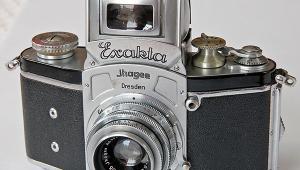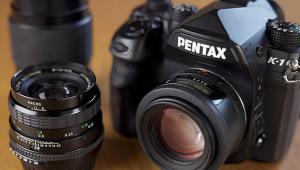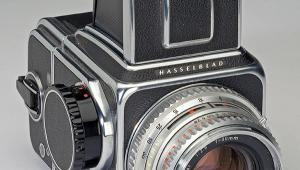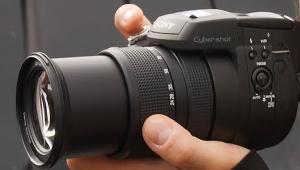The Rittreck IIa: A Multifunctional SLR
When it was launched in 1956, advertisements of the time claimed the Rittreck to be the world’s most versatile Single Lens Reflex (SLR). It’s a statement that would be difficult to argue with. How many other SLRs can you name that offered interchangeable lenses, interchangeable backs, close-up facilities, a choice of four different formats, and the option of shooting on roll film or cut film?
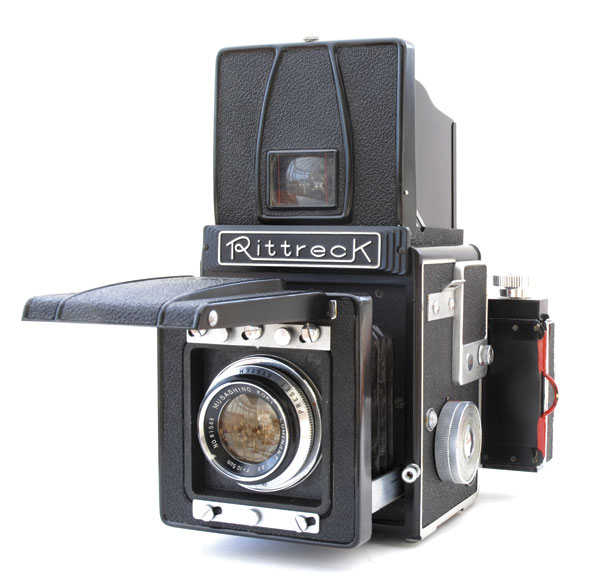
All Photos © John Wade
The Rittreck IIa, to give it its full name, was made by the Musashino Koki Company and was one of the very few 6x9cm SLRs to come out of Japan.
Its basic shape was pretty much conventional—a box with a lens on the front that moved back and forth on bellows, a film holder on the rear, and a focusing screen under a hood on the top. But it was big. With the hood up and the lens extended, it measured 9x6x7” (23x15x18cm) and weighed in at nearly 5 lbs (2.2 kilos).
Similar styles of camera had been seen for years before on large format plate or cut film SLRs from names like Thornton-Pickard and Ensign. They were also seen long after the demise of the Rittreck from the likes of Hasselblad, Bronica, and Mamiya. What set this camera apart from all the others was its sheer versatility. Let’s start with the way it handled different film formats.
The Rittreck usually came equipped with a multi-format rollfilm holder that took 120 size film. On the top there were three frame counters, each in its own small window. The first counted from one to 10, the second from one to 12, and the third from one to 15.

To load the camera, the holder was slid off the back and opened like a book, at which point all three of those counters automatically snapped back to “S” for start. With a film in place, the advance knob was turned counterclockwise, which wound the roll with the film on the outside and the backing paper on the inside.
With the holder slid back into place, a dark slide was removed and the camera was ready to take 6x7cm exposures, 10 to a roll, watching the numbers in the left frame counter window. To take 12 exposures in the 6x6cm format, a mask was inserted in the film holder in place of the dark slide and the numbers in the right window were used. For 6x4.5cm pictures, a different mask was inserted and the counter in the middle checked off the numbers from one to 15.
As the film advance knob was turned, all three counters moved, but were geared to advance by different increments, according to each of the formats. By watching the counters while juggling the masks, it was even possible to shoot all three formats on the same roll of film.
Another, now rarer film back worked in a similar way, but was equipped to take one format only: eight 6x9cm exposures. Also available were cut film holders for 6x9cm negatives, and a film pack back.

The extra-large focusing screen covered the full 6x9cm format, which anyone more used to looking at a Hasselblad or Bronica screen would find simply enormous. Lines were etched into the screen to cover 6x7cm, 6x6cm, and 6x4.5cm formats. The camera did not have an instant return mirror, so the image only appeared on the screen after a large shutter tensioning knob on the left of the body was turned. The shutter was a focal-plane type and a knob on the opposite side of the body set speeds of 1⁄20, 1⁄25, 1⁄50, 1⁄100, 1⁄200, and 1⁄400 sec.
How about lenses for this monster? The standard was a 10.5cm f/3.5 Musashino Koki Luminant, which stopped down to f/22. It had a preset feature that allowed the photographer to set the desired f/stop, while focusing at full aperture, then to twist a ring which automatically stopped the lens down to the one previously chosen.
The standard lens focused from infinity down to 18”, but could be adapted to focus even closer. In its conventional fitting, the lens screwed into a board that was recessed into the camera’s lens panel. But if the board was removed, and the lens unscrewed, the board could then be reversed so that the previously recessed part now stood proud of the body, and the lens could be remounted that much further from the film plane. While it no longer focused at infinity when mounted this way, it did bring close focus down to 13”.
For even closer focusing, the Rittreck had its own extension tubes which screwed into another lensboard, and with the standard 105mm fitted to the front end, 1:1 life-sized pictures could be taken.

A few years after the Rittreck was introduced, the camera was exported under the name of Optika IIa, and by the time of this launch, it had built up quite an arsenal of lenses. Alongside the standard 10.5cm f/3.5 Luminant, there was a 50mm f/4.5 Aetna Doryt; 135mm f/4.5, 180mm f/4.5, and 210mm f/6.3 Aetna Actinas; and a 300mm f/5.6 Tele-Luminant.
Each lens screwed into its own lensboard, enabling the interchange to be effected quickly and easily, simply by releasing a couple of catches, rather than having to unscrew one lens before screwing in another.
For flash photography, the Rittreck was synchronized for focal-plane bulbs at 1⁄25 sec or less, or electronic flash at 1⁄20 sec only.
According to brochures of the time, the manufacturers saw the Rittreck as an all-round system camera, suitable for studio and portrait work, as well as for sports, medical, and scientific photography. The brochure shows a photographer using the Rittreck at waist level to shoot a tennis match—not easy with the laterally-reversed viewfinder image inherent in cameras of this type.
The same brochure shows a medical photographer using the camera mounted on a column, equipped with bellows and attached to a microscope—a setup that would have demanded an extremely strong and heavy support if the weight of the camera wasn’t to topple the whole thing over.
Because of its size and weight, the Rittreck must have been best used for studio work. But even then photographers would have encountered difficulties because with the Rittreck mounted in the usual way and using the cut film holders, the 6x9cm back or the 6x7cm option, it was then wrongly orientated for portraiture.

This could be solved by mounting the camera on an auxiliary tripod bush on the side of the body, so that those two formats could then be used in a portrait shape, but then the focusing screen would have to be viewed at right angles to the subject and would have given an upside-down image.
There were no such problems, of course, if using the square 6x6cm mask, and the 6x4.5cm mask gave an upright, portrait-shaped image when the camera was tripod-mounted conventionally.
Yes, the Rittreck was versatile, but in many ways it was too versatile for its own good and Musashino Koki didn’t pursue this style of camera. In 1968, they produced the Rittreck 6x6, a rollfilm SLR for 6x6cm images on 120 or 220 film. In 1972, following several company reorganizations, they changed their name to the Wista Company Limited, which continues to trade today.
As a collector’s item, a Rittreck IIa with a multi-format back commands around $250-$300.

